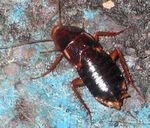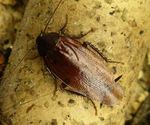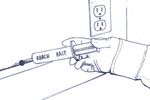Cockroach Biology and Management - Texas A&M AgriLife
←
→
Page content transcription
If your browser does not render page correctly, please read the page content below
ENTO-037
5/14
Cockroach Biology
and Management
Wizzie Brown, Michael Merchant, and Roger E. Gold*
C
ockroaches are among the most common American, oriental, and smokybrown cockroaches
insect pests in homes, schools, and busi- live mostly outdoors but may move indoors in
nesses. They like to eat many of the same search of food or water. Cockroaches also infest
foods we do and are especially troublesome wher- homes when brought in with groceries or boxes,
ever food is prepared or served. They also may and, once established, can readily move within
transfer disease-causing organisms. structures such as from apartment to apartment.
Fortunately, cockroaches can be controlled American cockroaches, also known as water-
with a little knowledge about their biology and bugs or palmetto bugs, are more common in com-
behavior, attention to sanitation, and effective use mercial buildings and are one of the most common
of commercially available insecticides. cockroaches in sewer systems. The largest cock-
roach in Texas, it can grow 1½ to 2 inches long.
Identifying cockroaches Both the adult male and the female can fly.
Adults are reddish brown (Fig. 1a), with tan to
Cockroaches have flattened bodies and heads
light-yellow bands outlining the pronotum. Young
that, when viewed from above, are concealed by a
nymphs are grayish brown, but after the first few
plate-like structure called a pronotum. They move
molts, they become more reddish brown (Fig. 1b).
surprisingly fast with their elongated, spiny legs.
Their long, thin antennae help them find food and
feel their way in the dark (which is when they are a b
most active). Cockroaches can be brown, black,
tan, reddish orange, or pale green. Most cock-
roaches have wings, although in some species the
wings are short and non-functional.
The most common types of cockroaches in
Texas are the American cockroach, Periplaneta
americana; German cockroach, Blattella ger-
manica; oriental cockroach, Blatta orientalis; and
smokybrown cockroach, Periplaneta fuliginosa.
German cockroaches spend their lives indoors.
*Extension Program Specialist-IPM; Professor and Extension
Urban Entomologist; and Professor and Endowed Chair in Urban Figure 1. American cockroach adult (a) and nymph (b),
and Structural Entomology, The Texas A&M University System also known as the palmetto bug or waterbug.American cockroaches are long-lived, reaching The smokybrown
adulthood and sexual maturity in an average of 600 cockroach is common
days. As adults, they usually live 1 to 2 years. outdoors, especially
German cockroach adults are ½ to ⅝ inch long in the more humid
and are light brown with two dark stripes on the areas of Texas and
pronotum (Fig. 2a). Both males and females have other southern states.
wings extending to the end of their abdomens but They prefer living Figure 4. Very young smoky-
they do not fly. Nymphs have wing pads and two in protected, moist, brown cockroach nymph.
dark stripes extending down the entire thorax and warm sites, away from
abdomen (Fig. 2b). moving air. Common habitats are ground cover, mulch,
palm fronds, soffits, eaves of attics, and tree holes.
a b Smokybrown cockroaches reach maturity in an average
of 600 days, and adults typically live 3 to 9 months.
Oriental cockroaches are dark brown to black and
grow to about 1¼ inches long. They do not fly and their
wings remain short, even as adults. The female’s wings
are smaller than the
male’s, which extend
Figure 2. Adult (a) and nymph (b) German cockroaches. only slightly over half
The adult female in this picture carries an egg case of the body (Fig. 5).
(ootheca) that will produce 30 to 40 small nymphs. Nymphs are uniformly
reddish brown to
German cockroaches are the most prolific of black. The develop-
Figure 5. The adult oriental
indoor cockroaches and can produce a generation ment time from egg to
cockroach is nearly jet black
in about 100 days. They are one of the most wide- adult averages 575 to with short wings. (Image
spread insect public health pests in urban homes, 600 days and adult from Clemson University,
apartments, and restaurants. They transport germs and oriental cockroaches bugwood.org.)
are associated with allergies and asthma. live 1 to 6 months.
German cockroaches do not live outdoors in Texas. They prefer cooler, ground-level sites such as base-
The Asian (Blattella asahinai) and field (Blattella vaga) ments, crawl spaces, and wet areas.
cockroaches look very similar to German cockroaches Turkestan cockroaches, Blatta lateralis, are
and may be found outdoors in some areas of the state. becoming more common in Texas, especially in
Smokybrown cockroaches are also large. Adults western parts of the state. Males and females look
reach 1¼ to 1½ inches long. They are dark brown to strikingly different (Fig. 6). The brownish yellow
black and their wings extend beyond the abdomen in adult males are 1/2 to 7/8 inch long. The pronotum has
both sexes (Fig. 3a). Their antennae are as long as or a pale margin, as do the upper corners of the front
longer than their bodies. Younger nymphs are black wings. The female Turkestan cockroach is similar to
with two white bands on the body and white-tipped the oriental cockroach—shiny, dark reddish brown
antennae (Fig. 4); older nymphs are uniformly reddish with short wings. However, the outer bases of the
brown (Fig. 3b). wings are pale like the male Turkestan cockroach.
a b a b
Figure 3. Smokybrown cockroach adult (a) and large Figure 6. Male (a) and female (b) adult Turkestan
nymph (b). cockroaches. (Images by Robin McLeod.)
2This species is native to Asia but was introduced If you are unsure where cockroaches are enter-
to California and is expanding its range into Texas. ing, place sticky card monitors, also called “roach
It has become one of the most common outdoor hotels” or “glue boards,” next to doors, behind laun-
cockroaches in El Paso, where it is found in com- dry appliances, under stoves and refrigerators, or
post, leaf litter, and potted plants; in expansion in other locations where cockroaches may travel or
joints of sidewalks; and around water meter boxes. hide. Sticky cards trap cockroaches and other crawl-
ing insects (Fig. 7). They are most useful for moni-
Cockroach biology toring and less effective for controlling cockroaches.
Nevertheless, they can provide some control, espe-
Cockroaches have a three-stage life cycle: egg,
cially for low numbers of larger cockroaches.
nymph, and adult. Mature females produce 12 to 36
To make a home less hospitable for cockroaches,
eggs at a time, depending on the species. The eggs
reduce clutter, keep mops and wet items off of floors,
are protected in a bean-shaped capsule, or ootheca
and eliminate food and water (for example, by
(oh-oh-THEE-kah). The number of oothecae that
washing dirty dishes and emptying pet water and
females produce depends on the species. The female
food bowls each night). Sticky cards (Fig. 8) placed
cockroach carries the egg capsule until it is mature
along walls and cabinet edges in utility rooms and
or she finds a secluded spot to glue it to a surface or
drop it. Some females carry it until just before the
eggs begin to hatch. After hatching, nymphs tend to
stay in dark, protected cracks and crevices, which
they often share with adult cockroaches.
At average indoor temperatures, it takes a
German cockroach nymph 50 to 60 days to develop
into an adult. The optimum temperature for German
cockroaches is around 80 degrees F. Warmer tem-
peratures shorten their development time and
increase the potential for population growth.
Most cockroach species are nocturnal—they Figure 7. Sticky card placed within a cupboard for
hide during the day and come out at night to look monitoring cockroaches.
for food. For example, the German cockroach
spends about 75 percent of its life in narrow cracks
and crevices, from 1/32 to 3/16 inch wide. From these
harborages, adults emerge at night to search for
food and water.
If you see cockroaches during the day, it usually
means there are a lot of them around. They tend to
congregate near sources of heat and moisture, which
accelerates their growth and reproductive rates.
Indoor cockroach control
Cockroaches are best controlled through an
integrated pest management process of inspection,
sanitation, exclusion, and the use of low-toxicity
insecticides.
Inspect
First, determine where cockroaches enter the
home and where they live. The larger types, such
as American and smokybrown cockroaches, often
Figure 8. Dots showing possible sticky card placement
enter a home or business through poorly sealed
for monitoring cockroaches.
doors, roof soffits, or floor drains.
3near exterior doors help monitor cockroaches and on the bait and return to their hiding places to die.
provide some control, especially for outdoor species. Baits are most effective when few other food alterna-
When German cockroaches are the problem, tives are available.
look for favored harborages or daytime hiding Using baits indoors. The most common con-
places. German cockroaches prefer cracks and crev- sumer bait formulations come in ready-to-use plas-
ices in warm locations near water and food. Look tic bait stations or tubes containing gel baits. When
for tiny droppings deposited around cockroach using pre-baited
harborages. The droppings look like crushed pepper containers, always
and stick to surfaces where cockroaches congregate. use enough stations
A good flashlight is essential for spotting cock- to effectively treat
roaches and their signs. infested rooms—at
Another way to identify cockroach harborages least one bait station
is to use a household hair dryer to flush cockroaches within 1 to 2 feet
out of hiding. Cockroaches dislike high tempera- of every suspected
tures and moving air and will flee when hot air is cockroach harborage.
directed into a harborage. Once you identify har- Follow the package
borages, treat or seal them to prevent further use. directions.
Place the bait
Remove food, water, and harborage stations near garbage
Good cleanup and sanitation practices are cans, under sinks,
Figure 9. Placing cockroach
essential to effective cockroach control. When food along cabinet edges,
bait station under a stove.
or water is scarce, cockroaches must search farther near cracks in cor- Stations are most effective if
each night to survive. Good sanitation puts stress ners, or under dish- placed along a wall or cabinet
on cockroach populations and increases the effec- washers, refrigera- edge.
tiveness of baits and other insecticides. tors, or stoves (Fig.
Clean the floors and counters and fix water 9). Place them horizontally or glued to a vertical
leaks to remove moisture sources. Seal cracks and location (Fig. 10). When using gel baits, it is more
crevices where cockroaches hide or enter buildings. effective to use many small placements (ideally, no
Use a good-quality caulk or sealant to close the gaps larger than pea-sized) than a few large ones. Avoid
around sinks and plumbing, in walls, and along using so much bait that it is easily seen or drips
kitchen splash guards. from the application site.
Examine the baits regularly and replenish them
Control cockroaches safely as needed to keep them fresh and in adequate supply
Traps alone do not provide sufficient control of for the cockroaches to eat. Baits work most effec-
well-established cockroach infestations. For them,
you will need to use a vacuum cleaner, bait, dust, or
spray.
Vacuums. Vacuum cleaners can be useful in
removing both cockroaches and their food sources
under stoves and behind refrigerators. In addition
to removing cockroaches, a vacuum cleaner helps
remove crumbs and other food that cockroaches
depend on. Make sure the vacuum has a HEPA filter
that can filter out the finest dust particles because
cockroach harborages often contain allergens that
can cause asthma or make breathing difficult for
some people.
Baits. A food mixed with an insecticide, baits Figure 10. Place baits in cracks and crevices where
cockroaches hide. Many small, pea-sized placements are
are among the most effective insecticides for con-
more effective than fewer, larger ones.
trolling cockroaches in homes. Cockroaches feed
4tively when cockroaches can feed freely and return tive and will always result in too much insecticide
to their harborages to die. being used. Use a damp cloth to immediately clean
Remove old, dried-up bait by removing the bait up any visible residues after a dust application.
station or scraping off the bait with a putty knife. Total-release aerosols and sprays. While
Avoid applying other pesticides such as dusts or efficient for killing flying insects and insects on
sprays close to bait stations, because cockroaches exposed surfaces, total-release aerosols (bug bombs)
will avoid contaminated baits. generally do not eliminate cockroaches because they
If a bait does not control the cockroach popula- do not penetrate the cracks where most cockroaches
tion within 2 to 3 weeks, try a different bait with hide. Likewise, insecticide sprays are not nearly as
a new active ingredient. Switch active ingredients effective as baits are for eliminating German cock-
regularly to avoid creating resistant cockroach roach infestations.
populations. If you use sprays or bug bombs, follow the direc-
Dusts. Some insecticides are sold in dust form. tions carefully and remove or cover all dishes, cook-
Dusts can be applied into wall voids that are other- ware, and utensils. Over-application of any pesticide
wise difficult to treat with sprays or baits. Dusts also is not only ineffective, but can be dangerous to you
can be transferred easily from one treated insect to and your family.
another during contact in harborage areas.
Effective dusts for cockroach control include
some plant-based insecticides and boric acid, which
Controlling other
remains one of the more effective cockroach control cockroaches outdoors
insecticides, especially when used properly. American, oriental, and smokybrown cock-
Do not apply boric acid or other dusts in the roaches are usually found outdoors and in nonfood
open or on countertops or shelves where they can areas of homes and commercial buildings. They
contaminate surfaces contacted by dishes, food become pests when they enter a home or business.
containers, people, or utensils. Good sites for using If you are unsure where cockroaches are getting in,
dusts include voids around plumbing (Fig. 11); use sticky card monitors.
under the dishwasher, refrigerator, and stove; and in Outdoors, look for dark, moist areas close to
cracks and crevices where baits cannot be applied. decaying organic food sources. Cockroaches can live
Dusts are most effective when applied lightly in compost piles, ground cover plants, hollow trees,
so that the residues are barely visible. Cockroaches mulch, old stumps, palm fronds, woodpiles, sewer
will avoid heavy dust deposits. The best way to apply manholes, and underground water meters.
dusts is to shake the container with the lid or cap American and oriental cockroaches use floor
on, remove the lid, and puff the dust lightly into the drains as common points of entry into buildings. To
void space. Applying dusts with a spoon is ineffec- minimize this risk, keep P-traps filled with water to
create a barrier between the sewer and the home or
business.
Check the threshold seals under doors and
ensure that roof soffits are screened to keep cock-
roaches outdoors.
Baits
Granular baits for cricket and cockroach control
work well, especially outdoors in ground covers and
mulched plant beds. Lightly sprinkle the bait accord-
ing to the label directions. Avoid applying visible
mounds of bait that might attract dogs or cats.
Containerized bait stations are available for
large cockroaches. Place the stations against walls,
Figure 11. Applying dust to a wall void where plumbing especially around doors and other suspected entry
pipes enter the wall. points.
5Using baits and non repellent insecticides such home utility areas. Spray suspected cockroach
as indoxacarb, chlorfenapyr or boric acid may harborages and entry points such as building perim-
improve control. eters, doors, soffits, and water boxes. In garages and
Insecticide sprays can also help manage utility rooms, spray the room edges and places that
outdoor cockroaches or treat them in garages and are unlikely to be contacted by children or pets.
Tips for professionals:
• Vary the type of insecticides used against German cockroaches. Rotating
both baits and sprays 1 or 2 times a year reduces the risk of insecticide
resistance, especially in apartments that are treated regularly for
cockroaches.
• When rotating insecticides, switch between insecticides with different modes
of action. See http://www.irac-online.org/teams/mode-of-action/ for more
information about insecticide resistance management.
• Pyrethroid insecticides are highly repellent to German cockroaches. Using
baits and non-repellent insecticides such as chlorfenapyr or boric acid may
improve control in difficult cases.
• Always carry a clean rag and putty knife for cleaning up old bait residues and
oversprays from liquid or dust applications.
• A good monitoring program can help you identify areas of cockroach activity
as well as document the effectiveness of your control program. Recording the
number of cockroaches in traps can be time-consuming, but may be useful,
especially in sensitive accounts or ones with many cockroaches.
Texas A&M AgriLife Extension Service
AgriLifeExtension.tamu.edu
More Extension publications can be found at AgriLifeBookstore.org
Educational programs of the Texas A&M AgriLife Extension Service are open to all people without regard to race, color, sex, religion, national origin, age,
disability, genetic information, or veteran status.
The Texas A&M University System, U.S. Department of Agriculture, and the County Commissioners Courts of Texas Cooperating.
Produced by Texas A&M AgriLife Communications
Revision
6You can also read



























































